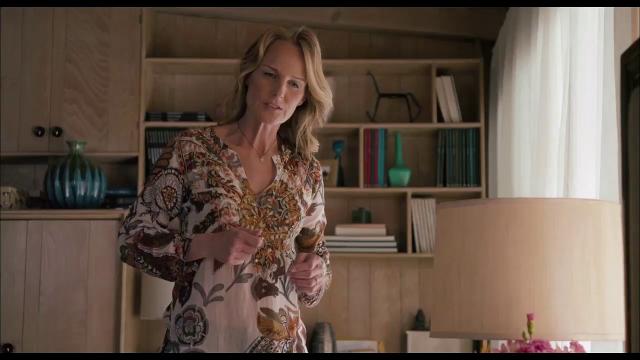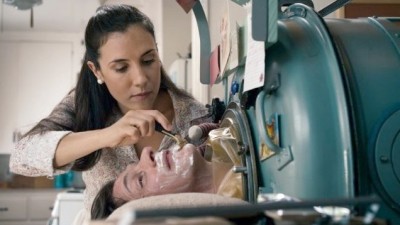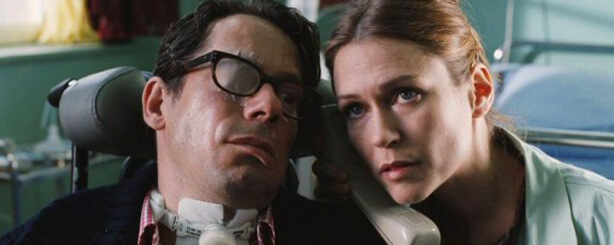It wasn't cinematic, complained a friend after a screening of The Sessions. Much as I might like to disagree with that friend, if only to make her life more difficult, it's a fair criticism of the film written and directed by Ben Lewin. Mr. Lewin's film, based on the story, "On Seeing a Sex Surrogate," by Mark O'Brien often plays like a television movie and not a terribly distinguished one at that.
Mark O'Brien was a journalist, poet and advocate for the disabled. The contraction of the polio virus during childhood deprived him of the use of his limbs for the remainder of his life and often confined him to an iron lung. Moving about Berkeley on a motorized gurney, he was able to complete a bachelor's degree in English literature in 1982. Illness prevented him from completing a masters degree, but he was still able to pursue a career in journalism. After writing an article on sex and disabled people, he was forced to confront fears about his own sexuality. A virgin at the age of 38, he decided to see a sex surrogate.
O'Brien was a Catholic. If nothing else, as he says in both The Sessions and in Jessica Yu's Oscar-winning documentary, Breathing Lessons: The Life and Work of Mark O'Brien, he liked the idea of having someone to blame. In The Sessions, he consults a priest, Father Brendan (William H. Macy), hopeful of gaining both divine go-ahead and friendly advice. The long-haired father is first taken aback, this being fornication after all. But this is also a Berkeley priest. After considering the matter, he says "In my heart, I feel like he'll (the other long-haired guy, J.C.) give you a free pass on this one." And later, rather more to the point, "Go for it."
 There was a real priest whom Mark O'Brien consulted, a Father Mike mentioned briefly in "On Seeing a Sex Surrogate." Macy's kindly cleric and even long hair seem reasonable to to the time and place and his brief description in O'Brien's article. The same might be said of the headband he's wearing and even the six pack in hand when he pays a visit to Mark's cramped apartment one afternoon. But the expansion of the relationship for the sake of the film seems a rather transparent device to get across exposition in a pleasantly distracting and feel-good manner.
There was a real priest whom Mark O'Brien consulted, a Father Mike mentioned briefly in "On Seeing a Sex Surrogate." Macy's kindly cleric and even long hair seem reasonable to to the time and place and his brief description in O'Brien's article. The same might be said of the headband he's wearing and even the six pack in hand when he pays a visit to Mark's cramped apartment one afternoon. But the expansion of the relationship for the sake of the film seems a rather transparent device to get across exposition in a pleasantly distracting and feel-good manner. Much the same can be said of the device used by writer and director Lewin with the surrogate Cheryl Cohen Greene (Helen Hunt), who shares the actual name of the surrogate employed by Mark O'Brien. Lewin has Cohen Greene dictating case notes into a hand-held tape recorder. Probably not such an usual thing for a therapist to do, but the dictation is clearly directed at the audience as much as the recorder. This more clinical laying out of exposition is the sort of shortcut that takes the place of revealing dialog or a keen director's eye.
 So we have a film whose execution wouldn't be out of place on, say, Lifetime, or ABC, if such a network were fortunate enough to employ actors of the caliber of John Hawkes (O'Brien), William H. Macy and Helen Hunt for a single project. Most of Mr. Lewin's work has actually occurred in television.
So we have a film whose execution wouldn't be out of place on, say, Lifetime, or ABC, if such a network were fortunate enough to employ actors of the caliber of John Hawkes (O'Brien), William H. Macy and Helen Hunt for a single project. Most of Mr. Lewin's work has actually occurred in television. The subject matter, however, is rather more the stuff of HBO or the theoretically more open arena of the cinema. There is not only the depiction of a disabled man working with a sex surrogate, but almost complete nudity on the part of Ms. Hunt. What of O'Brien and is cinematic proxy John Hawkes?, one might ask. Here we would seem to meet not only the conservatism of the film industry, but one of it's most ruthless double standards. Given the subject matter of the story, the workings of Mr. O'Brien's sex organ are rather central to the discussion and action. And The Sessions depicts in flashback a scene whose significance is clear in O'Brien's account of the experience. Cohen Greene showed him his naked body in a mirror. It was a revelation to O'Brien. He didn't see the ugly, twisted body of a polio victim he imagined; he simply saw a man aroused. Like any other man in that situation. Lewin's brief flashback to this crucial moment is effective in its brevity and the wonder conveyed by Hawkes, but it also demonstrates how The Sessions is, sadly, all too cinematic, even by the supposedly enlightened standards of art house cinema.
Showing a naked Hawkes might well have bought The Sessions an NC-17 rating and cut into its modest take at the box office. It's quite acceptable for an American film audience to gaze upon a woman in almost full-frontal nudity, but not a man. The latter is most likely to take place beyond television and commercial cinema in the realm of art museum. I happened to see a demonstration of this divide on the same weekend, viewing The Sessions on Saturday night and an exhibition on Steve McQueen (the filmmaker, most recently responsible for Hunger (2008) and Shame (2011) ) at the Art Institute of Chicago the next day. The McQueen exhibition included an early short entitled Bear. The 16mm black and white film depicts two naked men in a kind of wrestling match, speaking to a connection between violence and eroticism.
The demands on Hunt in The Sessions are considerable. She has little place to hide, emotionally or physically. One gets close and repeated looks at a face which would seem to have had the influence of Botox, plastic surgery, or some combination thereof. Much as one might say that such things are sadly obvious, that it's a shame that an actress feels the need to take this step, she's working in an industry that requires her, like the surrogate of Mark O'Brien, to meet her male counterpart much more than half way.
So likable are the principals and so moving are the emotional basics of the story that The Sessions can't help but succeed to its modest extent. Macy and Hawkes are as sure and watchable as ever. Mr. Hawkes has done more striking work in recent years, but his role as Mark O'Brien, acting usually at 90 degrees from the camera's gaze and speaking in a voice that sounds like a sedated David Sedaris (which is relatively close to the voice of the real Mark O'Brien), is yet another demonstration of his range. He's completely credible as the most gentle of characters, here or perhaps even more fully with his role in Me and You and Everyone We Know (2005). And if you've seen Winter's Bone (2010) or Martha Marcy Mae Marlene (2011), you know just how frightening, how formidable this man of slight physical presence can be. Despite a wavering Massachusetts accent, this might actually be Helen Hunt's film even more than Hawk's. Her's is brave and deeply felt work as the sex surrogate whose self-imposed boundaries are challenged by her feelings for her client (this too, seemingly an exaggeration on the part of Lewin's film).
I can only assume that The Sessions was a more personal than average project for writer and director Ben Lewin. Mr. Lewin himself is a polio survivor whose mobility has been compromised since childhood (if not nearly to the extent than was the case with Mark O'Brien). Unfortunately and ironically, this episode from Mark O'Brien's life would have been better served by a different writer and director. Despite whatever affinity Mr. Lewin might possess for the late Mark O'Brien, he's made a film that gets issues across but reduces the character at its center.
 Typical of old-fashioned, movie of the week handling is The Sessions final shot. This after O'Brien's funeral (he died in 1999). We see his hushed, darkened apartment and the large, metal capsule of the iron lung in the center of the frame. Clearly, the device was a major and limiting component of Mark O'Brien's existence. " It's huge and ugly and yellow, but it works, said O'Brien of his iron lung. But he also said "Disability causes me to believe more strongly in a duality between body and spirit. Because I don't want to be this body, I want to be the soul." That last statement can be heard in Jessica Yu's, Breathing Lessons: The Life and Work of Mark O'Brien (1996). In a mere 34 minutes, Ms. Yu manages to give us a much better idea of Mark O'Brien than all 95 minutes of The Sessions.
Typical of old-fashioned, movie of the week handling is The Sessions final shot. This after O'Brien's funeral (he died in 1999). We see his hushed, darkened apartment and the large, metal capsule of the iron lung in the center of the frame. Clearly, the device was a major and limiting component of Mark O'Brien's existence. " It's huge and ugly and yellow, but it works, said O'Brien of his iron lung. But he also said "Disability causes me to believe more strongly in a duality between body and spirit. Because I don't want to be this body, I want to be the soul." That last statement can be heard in Jessica Yu's, Breathing Lessons: The Life and Work of Mark O'Brien (1996). In a mere 34 minutes, Ms. Yu manages to give us a much better idea of Mark O'Brien than all 95 minutes of The Sessions.
Instead of having us see the iron lung as the closing image of his film, Mr. Lewin would have been done better to show us the motorized gurney on which Mark O'Brien guided himself around Berkeley and its campus, often to the peril of himself and those in his unpredictable path. The gurney could well have served as a symbol of his desire to transcend polio, to be more than "this body." Even better, writer and director Lewin could have given us a stronger sense of of the perseverance that took Mark O'Brien out of the ugly, yellow capsule, out of the cluttered containment of his apartment and into the streets of Berkeley. A better idea of his sadness, his intelligence, his wit, his words. Lewin does often use O'Brien's words, as with a poem about the iron lung, but not necessarily the best ones; O'Brien was more articulate than he appears in The Sessions.
It's got to be a challenge to visually tell a story of a man who can move little more than his lips. It requires imagination. The sort of imagination brought to bear by Julian Schnabel in filming The Diving Bell and the Butterfly, Jean-Dominique Bauby's memoir of the same name. Bauby's mobility, after a catastrophic stroke, was reduced to the blinking of a single eyelid. Of course, this did not stop him from completing his memoir, nor Schnabel from realizing his story on film in a manner moving and even profound.
 |
| Mathieu Almaric as Jean-Dominique Bauby in The Diving Bell and he Butterfly. |
One can hardly blame Ben Lewin for lacking the sort of bravura demonstrated by Schnabel with "Diving Bell." However, much as any cinematic treatment of a person's story runs the risk of making that person larger than life, Lewin actually renders his subject slightly smaller than life. The Sessions might be a nice place to start with the life of Mark O'Brien. But lacking a fictional treatment of greater imagination and insight, one would do well to also watch Jessica Yu's documentary. Ms. Yu wisely let the man speak for himself.
Breathing Lessons: The Life and Work of Mark O'Brien can be viewed for free on the web. By all means, see it. One warning, however: if you watch the films at the snagfilms.com site as did I, be prepared to suffer the interruption - sometimes as O'Brien is in mid-sentence - of a smiling Kate Hudson selling Almay cosmetics.
Breathing Lessons: The Life and Work of Mark O'Brien can be viewed for free on the web. By all means, see it. One warning, however: if you watch the films at the snagfilms.com site as did I, be prepared to suffer the interruption - sometimes as O'Brien is in mid-sentence - of a smiling Kate Hudson selling Almay cosmetics.
 |
| The real Mark O'Brien |


Comments
Post a Comment